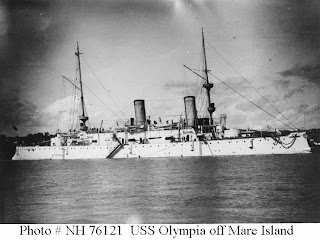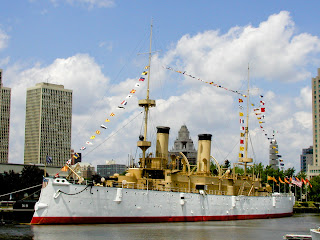The cruiser USS Olympia is the oldest steel warship afloat in the world. She was built in San Francisco and commissioned in 1895–making her almost 120 years old. Her career with the U.S. Navy was a long and storied one; she fought in the Spanish-American War in 1898 and saw action during and after World War I before being decommissioned in 1922.
 She is the last surviving naval ship afloat from the U.S. Navy’s fleet from the Spanish-American War, and the last floating example of a U.S. “Pre-Dreadnought” warship. She was built during an era of transition for the U.S. Navy, as it began to move away from being a coastal defense, commerce raiding navy to an ocean-going, front-line fighting navy. As such, some of her characteristics were contradictory, as the ship somewhat straddled these two roles. For example, she was built with a new type of vertical triple-expansion steam engines, among the most powerful mounted on a U.S. Naval ship at the time. She was also one of the first ships to have electricity and power-steering gear. Yet, at the same time she still had a set of sails she could mount on her masts in case her powerful engines failed. She was also unique in another respect: USS Olympia was built as an effective commerce raiding cruiser, and at the time of her design it was expected that a number of ships would be built based on Olympia‘s design. However, no further Olympia-class ships were ever built, because the Navy was moving away from commerce cruisers toward larger, more powerful battleships and armored cruisers.
She is the last surviving naval ship afloat from the U.S. Navy’s fleet from the Spanish-American War, and the last floating example of a U.S. “Pre-Dreadnought” warship. She was built during an era of transition for the U.S. Navy, as it began to move away from being a coastal defense, commerce raiding navy to an ocean-going, front-line fighting navy. As such, some of her characteristics were contradictory, as the ship somewhat straddled these two roles. For example, she was built with a new type of vertical triple-expansion steam engines, among the most powerful mounted on a U.S. Naval ship at the time. She was also one of the first ships to have electricity and power-steering gear. Yet, at the same time she still had a set of sails she could mount on her masts in case her powerful engines failed. She was also unique in another respect: USS Olympia was built as an effective commerce raiding cruiser, and at the time of her design it was expected that a number of ships would be built based on Olympia‘s design. However, no further Olympia-class ships were ever built, because the Navy was moving away from commerce cruisers toward larger, more powerful battleships and armored cruisers.
Despite this, Olympia was an effective ship. Upon her commissioning in 1895, she was assigned to the Asiatic Squadron, which was at the time was one of the fleets the U.S. Navy operated in the Pacific Ocean. When the U.S. declared war on Spain in 1898, the three-year-old ship was serving as flagship of the squadron. Her most significant action during the war her participation in the Battle of Manila Bay on May 1, 1898, during which the Asiatic Squadron. Leading the line of battle of the Asiatic Fleet into Manila Bay, it was on her decks that the squadron’s leader, Commodore Dewey, opened the battle by giving his now immortalized order, “You may fire when ready, Gridley.” (This scene is depicted in the painting at left.) With that, Captain Charles “Steve” Gridley, commanding officer of the USS Olympia, opened fire from her 8″ inch main battery and led in the destruction of seven of the thirteen ships of the Spanish fleet. After winning the battle, the squadron assisted in the capture of Manila itself.
She served her country for more than two decades after the Spanish-American War. During World War I, she escorted convoys and helped back an ill-fated Allied invasion of Russia in May 1918 in an ill-fated attempt to stop the Russian bolsheviks from taking over the country.
One of her last and most solemn official acts occurred in 1921, when she was sent to Le Havre, France to retrieve the remains of the Unknown Soldier. On the trip back to the U.S., she encountered a large storm and almost sank; however, she delivered the remains of the soldier to Washington D.C. in November 1921. The remains are now interred at the Arlington National Cemetary. Olympia decommissioned for the last time the following year.
She was laid up in reserve until 1957, when the government transferred the ship to the Cruiser Olympia Association; the association restored the ship to her appearance during the Spanish-American War and opened her as a museum in Philidelphia. However, maintaining a century-old ship is a very expensive business, and the current owner of the ship, the Independence Seaport Museum, announced earlier this year that they can no longer afford to maintain the ship, which is in need of at least $10 million in repairs to prevent her hull from deteriorating. If this money cannot be raised, the Olympia likely will be sunk as an artificial reef.
Olympia is a unique relic of her era and should not be sunk as a reef! To learn how you can help save her, visit the Friends of the Cruise Olympia and donate a small amount to make sure future generations will be able to walk her decks and experience a living piece of American history.


